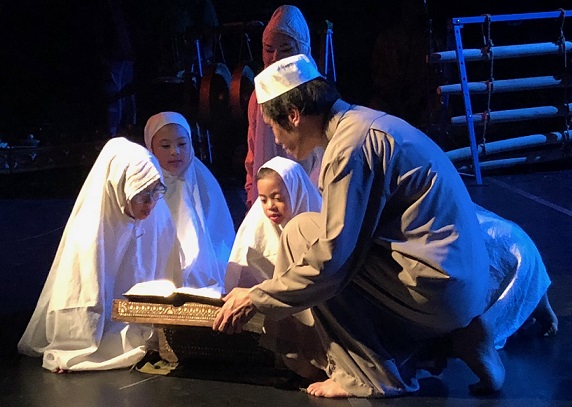‘Mindanao the Legend’ unfolds centuries-old history of resistance and resilience

The Dance of the Plates is believed to have originated from Indonesia and spread throughout Asia’s Islamic region which includes Mindanao. The FilAm Photos
On December 3, 2017, a lumad leader was killed by the military in Lake Sebu town of South Cotabato. Datu Victor Danyan was one of eight indigenous folks from the T’boli-Manobo tribe slain while defending their ancestral lands. Reports say he was killed in a “hail of bullets.”
The theatre group Kinding Sindaw (Dance of Light) opened its latest production, “Mindanao: The Legend of Tabunaway, Mamalu and Their Descendants,” with the death of the beloved Datu Victor. The thunder of gunfire made it a climactic preface.
The audience was then led to an adjoining room at La MaMa Theatre in the East Village where the centuries-old history of Mindanao unfolded in dance, narrative chanting, martial arts, and ritual over two hours. Three-year-old Grant Gabisan was “very transfixed,” said his mother Leizle Gabisan, a radiologist at Monmouth Medical Center. Leizle sat Grant on her lap as they watched the show, the boy was quiet and not stirring at all.
“The dancing, the costumes, the music. There’s so much to look at,” she said by way of explaining how her son appeared mesmerized.
Two brothers
“Mindanao” is the mythical story of two brothers – Tabunaway and Mamalu – who descended from a legendary goddess. Act 1 shows the two brothers, their respective clans and tribes and how they live their lives before the coming of Islam. They are portrayed as slash-and-burn farmers who planted corn, and sourced water from the waterfall. Everything is done with utmost respect for Mother Nature.
The brothers’ clannish bond was tested with the arrival of Arab traders who bring a new way of life and introduced the religion of Islam. Tabunaway welcomes the traders and converts to Islam. A defiant Mamalu wants nothing to do with the foreigners and distances himself from his brother’s territory. As Tabunaway’s people are settled by the rivers and lakes, Mamalu’s flock recede into the mountains which became their home.
The integration between the Arabs and the local people has, for the most part, created a thriving merchant community as the people learn from each other while observing the Islamic way of life.
Act 2 depicts the arrival of the Spaniards and other invaders. This was around the 1600s when Sultan Kudarat fought the westerners to prevent the spread of Catholicism. The Americans followed and brought with them Hollywood-style entertainment. There was widespread resistance. They cannot control the natives, so they massacre villagers, and violate the women.
Wealthy Filipino landlords become interested in tribal land, offering to buy them. The Muslim resistance continues, but this time it is not directed at foreign conquerors but toward fellow Filipinos. The story ends on the optimistic note, articulated by Kinding Sindaw Artistic Director Potri Ranka Manis, that “if you remember the resilience of your ancestors, you can never be conquered.”
For 25 years, Kinding Sindaw has been staging colorful Muslim productions like this one. If you’re a Filipino born in New York, chances are whatever knowledge you have of Mindanao may have been shaped by Kinding Sindaw’s dances and traditional movements, and Potri’s lectures about Mindanao history and politics.
“There is so much untold legends, myths, and untold history,” Potri told The FilAm during intermission. “This is our story, not (a story) from the minds of conquerors.”
About 80 percent of Kinding Sindaw dancers come from Mindanao, said Potri. Not all of them are trained dancers, but those who were born in Mindanao remember the traditional movements they grew up with and can easily follow. There is, for instance, Mohammad Zebedee Dimaporo, a scion of the Dimaporo clan of Lanao, who played Tabunaway. He works in insurance and financial services.
The Morales family – seven of them – are also in the cast, aware about the need to preserve their traditions as Muslims. The mother Bai Lani Kalipa, a registered nurse, is a Maguindanao tradition bearer. Her husband Dan Morales, who works as a mechanic, played alternately an Arab, Spaniard, American and Filipino soldier. Their five daughters are part of the chorus.
“We also have a baby in the cast,” said Potri. The infant was heard crying in a scene where the indigenous families are seen celebrating in dance and rituals. It was perfect.
© The FilAm 2018















